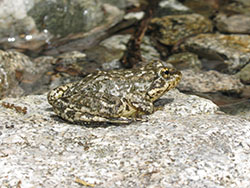Many years of painstaking monitoring and assessment efforts undertaken by CDFW have helped guide an ongoing effort to bolster the dwindling populations of mountain yellow-legged frogs in Southern California.

Yellow-Legged Frog

Mountain Yellow-Legged Frog habitat
Many years of painstaking monitoring and assessment efforts undertaken by CDFW have helped guide an ongoing effort to bolster the dwindling populations of mountain yellow-legged frogs in Southern California.
Tim Hovey, a senior environmental scientist in CDFW’s South Coast Region, has been hiking through the forest to monitor and evaluate yellow-legged frogs in Little Rock Creek and Big Rock Creek in the Angeles National Forest since 2002, when they were listed under the Endangered Species Act (they were listed as state endangered in 2013). At that time, it was estimated that fewer than 100 adult frogs remained in the wild.
The drastic decline of this population over the last 50 years has been a cause for concern to biologists. “The mountain yellow-legged frog is a critical part of the fragile stream ecosystem here in Southern California,” Hovey explains. “We hope that our efforts to increase the wild population through captive tadpole release will eventually lead to self-sustaining populations that will no longer require captive care to recover.”
Hovey estimates that fewer than 400 adult mountain yellow-legged frogs currently exist in the wild in small populations throughout its range in Southern California. Threats to the species include habitat loss, pollution, non-native predators and the deadly amphibian disease chytridiomycosis, which is caused by the chytrid fungus. Some measures have already been taken to help the species. From 2002 to 2012, for example, CDFW was the lead agency involved in removing non-native predatory fish in a section of Little Rock Creek, located below the current mountain yellow-legged frog population, which essentially doubled the amount of high-quality habitat available for frogs in the stream.
But more human intervention is necessary, in the form of captive rearing. The multi-pronged effort to bolster mountain yellow-legged frogs includes contributions from the U.S. Fish and Wildlife Service, the Los Angeles Zoo, San Diego Zoo Global, the U.S. Forest Service, the U.S. Geological Survey (USGS), and others.
According to Hovey, the captive rearing project began in 2014, when wild-caught tadpoles were removed from Little Rock Creek and Big Rock Creek by USGS staff during a breeding cycle. The tadpoles were raised to adulthood in captivity at the Los Angeles Zoo in temperature-controlled aquaria in a quiet frog-rearing room, carefully equipped to mimic the frogs’ natural life cycle conditions.
While the tadpoles were growing, CDFW staff conducted field surveys to evaluate suitable habitat, using the data to identify specific streams where mountain yellow-legged frogs could potentially be released. The criteria for evaluation considered current recreational uses, access for monitoring, safety and property ownership. The resulting list of approved locations was reviewed by the other agencies and is being used to guide the releases.
On June 26, 500 tadpoles, descendants of the captive Big Rock Creek frogs, were released back into their historic range in the lower section of Big Rock Creek in the Angeles National Forest. Another 500 tadpoles, offspring of the Little Rock Creek captive group, were released on June 27 into Devils Canyon Creek in the Angeles National Forest. The offspring of the captive frogs, which were bred and kept separate, were released into their creeks of origin.
“These releases represent a promising first step in the recovery of mountain yellow-legged frogs, as well as hopefully establishing new populations in areas where the frog has been absent for over fifty years,” Hovey said. “We hope that with continued agency coordination and continued tadpole releases, the dwindling numbers of these endangered frogs will slowly begin to rebound and recover.”
This was the first release of tadpoles into Angeles National Forest with several more scheduled this summer throughout portions of the species’ range.
###
CDFW Photos courtesy of Tim Hovey. Top Photo: Mountain Yellow-Legged Frog.
For more information:
US Fish and Wildlife Service, “Trailblazing Tadpoles”
US Fish and Wildlife Service, Draft Recovery Plan for the Mountain Yellow-Legged Frog
CDFW, Mountain Yellow-Legged Frog, description and taxonomy